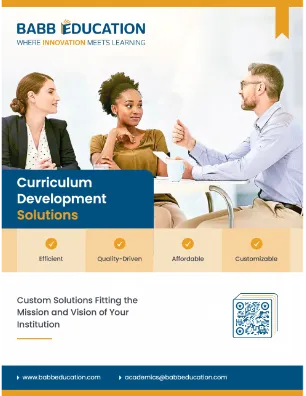UDL is a framework aiming to optimize teaching and learning by providing all individuals with equal opportunities to learn.
In the realm of online education, a primary goal is to create courses that are accessible and accommodating to all students. Babb Education’s instructional designers commit to this mission by employing the principles of Universal Design for Learning (UDL) in every course they create or revise. UDL is a framework aiming to optimize teaching and learning by providing all individuals with equal opportunities to learn. This blog explores some practical tips for using UDL to create flexible learning environments to support the diverse needs of all students.
Understanding Universal Design for Learning (UDL)
UDL is an educational approach which recognizes the variability of learners and seeks to accommodate this by designing flexible learning environments. The UDL framework is based on three main principles:
- Multiple Means of Engagement: Focus on the "why" of learning by providing various ways to engage and motivate students, recognizing that different students are motivated by different stimuli.
- Multiple Means of Representation: Addresses the "what" of learning through presenting information in multiple ways to cater to the diverse ways students perceive and comprehend information.
- Multiple Means of Action and Expression: Consider the "how" of learning by offering students various ways to demonstrate what they have learned, acknowledging that students express their understanding in different ways.
Practical Tips for Implementing UDL in Online Courses
Babb Education’s instructional designers work with faculty to employ these practical tips to effectively integrate UDL principles into online courses.
- Diversify Instructional Methods
Engage students through varied instructional methods to cater to different learning preferences. For example:
- Videos and Podcasts: Use multimedia content to provide information in different formats, such as creating video lectures and podcasts to complement traditional reading material.
- Interactive Activities: Incorporate interactive elements such as simulations, field work, and/or gamification to actively engage students and cater to kinesthetic learners.
- Visual Aids: Use infographics, charts, and diagrams to represent information to help visual learners grasp complex concepts more easily.
- Provide Accessible Materials
Ensure all course materials are accessible to students with different needs. Examples include:
- Closed Captions and Transcripts: Provide closed captions for videos and transcripts for audio content to support students with hearing impairments and those who prefer reading over listening.
- Alt Text for Images: Add descriptive alt text to images, graphs, and charts to ensure students using screen readers can understand the visual content.
- Accessible Documents: Use accessible document formats such as tagged PDFs and ensure all documents can be read by screen readers.
- Offer Multiple Means of Engagement
Motivate students by providing diverse ways for them to engage with their instructor, course content, and their peers. Strategies include:
- Choice in Assignments: Allow students to choose from a variety of assignment formats, such as written reports, presentations, or creative projects, to demonstrate their understanding in a way suitable to their strengths.
- Interactive Discussions: Facilitate online discussions and debates on course topics. Use discussion boards, chat rooms, and video conferencing to create a sense of community and encourage peer interaction.
- Gamification: Incorporate game-based elements, such as leaderboards and badges, to increase motivation and engagement.
- Create Flexible Assessments
Design assessments to accommodate different ways of demonstrating knowledge and skills. These can include:
- Variety in Assessment Types: Use a range of assessment types, such as multiple-choice quizzes, open-ended essays, and practical projects, to cater to different learning styles.
- Flexible Deadlines: Offer flexible deadlines or allow for extensions to accommodate students with varying schedules and responsibilities.
- Formative Assessments: Incorporate low-stake formative assessments to provide ongoing feedback and support, helping students to improve before they attempt high-stake assessments.
- Foster a Supportive Learning Environment
Create an inclusive and supportive online learning environment by:
- Clear Communication: Provide clear and consistent communication regarding course expectations, deadlines, and resources. Use multiple channels, for example, email, announcements, discussion boards, and office hours to reach all students.
- Frequent Feedback: Offer frequent, constructive, and substantive feedback on assignments and participation to guide students’ progress and encourage their improvement.
- Inclusive Language: Use inclusive language and examples in course materials reflective of the diversity of the student body with the aim of making all students feel represented and valued.
Examples of UDL in Action
To illustrate the practical application of UDL principles, consider these two examples:
Example 1: History Course
Engagement: The instructor offers a variety of ways to engage with the course content, including video lectures, interactive timelines, and virtual field trips to historical sites.
Representation: Information is presented through a combination of written texts, audio recordings, and visual aids, such as maps and primary source documents.
Action and Expression: Students can choose to demonstrate their understanding through traditional essays, multimedia presentations, or creative projects, such as reenactments or digital storytelling.
Example 2: Marketing Course
Engagement: The instructor offers a variety of ways to engage with the course content, including video lectures on key marketing concepts, interactive case studies, and virtual guest lectures from industry professionals.
Representation: Information is presented through a combination of written texts, infographics, and videos. The instructor also provides access to marketing research reports, current industry articles, and podcasts featuring marketing experts discussing the latest trends and strategies.
Action and Expression: Students can choose to demonstrate their understanding through a variety of formats, such as traditional essays analyzing marketing strategies, multimedia presentations proposing new marketing campaigns, or creative projects like developing a comprehensive marketing plan for a hypothetical product.
The Impact of UDL on Student Success
Implementing UDL principles in online courses creates a more inclusive learning environment and enhances overall student success. By accommodating diverse learning needs and preferences, UDL helps to:
- Increase Student Engagement: Offering multiple ways to engage with the content and participate in the course fosters a more dynamic and interactive learning experience.
- Improve Accessibility: Ensuring all materials and activities are accessible to students with different needs promotes equity and inclusion.
- Enhance Learning Outcomes: Providing diverse means of representation and assessment allows students to both learn, and demonstrate, their knowledge in ways that align with their strengths, leading to better learning outcomes.
- Reduce Barriers to Learning: By proactively addressing potential barriers, UDL helps all students fully participate and succeed in the course, regardless of their individual circumstances.
At Babb Education, our commitment to employing Universal Design for Learning principles ensures we work with faculty, to create online courses that are accessible, inclusive, and interactive for all students. By diversifying instructional methods, providing accessible materials, offering multiple means of engagement, creating flexible assessments, and fostering a supportive learning environment, we help educators design courses that accommodate the diverse needs of their students.
Reach out to Babb Education today to learn more about how we can help you implement UDL principles in your online courses. Together, we can create a flexible and inclusive learning environment that empowers all students to achieve their full potential!



